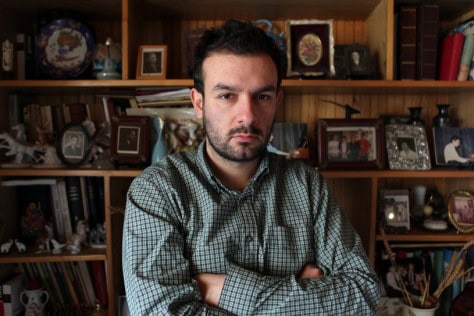Sweden's Envelopes dazzled U.S. and Swedish listeners alike with their 2005 debut, Demon, an experiment in bridging the gaps between indie-rock, the grunge of the early-90s, bedroom recordings, and straight-up rock. After a couple of singles and EPs, the quintet is back with a new album (this time studio recorded and produced), Here Comes the Wind, out now Brille Records.
For starters, tell me what you've been doing since the release of Demon? Where did you tour and for how long? Where did you record the album? Have you been working on other projects outside of Envelopes?
Since Demon we've been working on Here Comes the Wind. After we tried to record it on our own in a farm in the UK countryside, we finally recorded it in Sweden, at the Tambourine Studios in Malmö with Per Sunding, the guy from Eggstone. Listen to their album Vive la Difference if you like us… you're gonna like it too. And since we've been done with it… what did we do? We made some videos like the one for “Life on the Beach,” for which we buried a team of seven dancers in sand and built a fake beach in Stockholm for our photoshoot; funny stuff like that. Otherwise we've just been wandering over different places trying to earn some money. Outside Envelopes, Henrik is hanging out in Berlin with the hard core dance scene, Fredrik is playing gigs with the best Swedish musicians from the 90s, I'm making poorly recorded demos and exchanging them here and there with some happy friends from the UK.
You've changed your sound up quite a bit since the debut. Audrey sings more often; the songs are more densely structured, I think; the production is way cleaner, crisper. This LP sounds less like a jumble of demos and more like a studio LP. Why the change and how did it come about?
You're right about the dense structure; we've gotten even further than on Demon which [was already pretty packed]. About me singing more, do I really? On Demon, I sang five songs and choruses on the rest, and now I sing four, and the rest choruses… or maybe more like verses, so it’s basically the same. They're just recorded better so you hear more maybe? Same for the sound: of course its sounds different because we recorded in a real studio so we have a super good drum sound etc., but still I found more similarities between Here Comes the Wind and Demon than I found differences. When I listened to the whole thing just after it was mastered, I remember I thought like, “shit (in a good way) we did it again?” It was interesting to realize that again all the songs were very different to each other and very recognizable from each other, and even if it was very organized, so many things were happening that you could still say it was a mess; and since the songs are so different you could say its a mess inside the album too. But it’s the kind of clever mess I enjoy. I don’t understand how we did it.
I've always been very interested to know who exactly it is that you draw your inspiration from, or at least what kind of music you like. Some of your stuff is heavy like early Breeders or Pixies; other stuff is light and poppy in that distinguishably Swedish way; other tunes still are sort of psychedelic in origin (“Heaven,” for example). You've a diverse sound, to say the least. Where does it all come from?
We are in awe in front of Pixies of course. We're happy when we do stuff that feel like them consciously or not. Its true that songs are all very different. I Can't explain why. Probably 'cos we're all participating so it gives different inputs.
And on a related note, how do you construct the songs themselves? Who writes the lyrics, who does the arrangements, and so on?
The songs evolve a lot. Usually Henrik does rhythm guitar and singing and Fredrik and I add guitars on top of it. And then it starts growing. Maya, our ex-bass player, wrote a lot of songs too… he's really talented. Sometimes Henrik just found an insane but very advanced technique to create a bass line and Fredrik made guitars and programed computer voices for it, like for “Put on Hold.” Sometimes I write lyrics, like the rubbish talk in “Freejazz,” and the singing in “Boat.” Its open. There're no strict rules. Except for one so far: Henrik has [veto power] on the arrangements and can choose the sound for everything. As Maya used to say “the band is an agreed upon and acknowledged dictatorship.”
I love listening to the older demos and versions of some of your songs and comparing them to the new ones. “Freejazz” as featured on the LP is quite a bit different from the one on your EP. The new “Party” sounds different, as does “I'd Like 2 C U,” and just about every song on the album that's either been on an EP or on your MySpace page in the last year. I like your artistic openness in that regard. When does a song become “complete” to you? How do you continue to fix them up, edit them?
Yeah, its true that you got some early versions we had this summer. Between then and now there's been more mixing, and the mastering etc. Mixing can last weeks even with all the new tricks they put in ProTools to save time. Fredrik could spend hours fixing one single hi-hat sound, while everybody whispered behind his back, “what is he doing? I don’t know.” But it worked finally.
There is an even older version of “Freejazz” than the one on the EP: the very first “Freejazz” version ever. directly from Henrik´s summer house in the winter 2004. I listened to it one million times. It has a very good energy. The one we made with James Ford, too, [has such a groovy opening bass line]. We lost that in the album version I think. But other parts of the song are much better.
Where does the title, Here Comes the Wind, come from?
From the last track, “Seawise,” at the end of the song.
And who did the album artwork and seal/emblem? I really like the whole feel of this record… like a more matured, sophisticated version of Demon.
It’s by a designer named Sam Blunden. He has done a lot of great artwork for us. Its always a pleasure working with him; you know you're gonna do something good and have a lot of fun on the way. First we wanted to have old sport cars from the 60s―there were tons of great pictures in the studio―but then Sam found all those paintings from the Maritime Museum in London. There were some with sea monsters that looked just like big cats heads… that was funny. But finally we took the boat in the dramatic storm one since we felt like, “yeah, that's it… that's our life.”
Who do you all envision the Envelopes fan as? Who is this album made for?
I wish animals could listen to Envelopes and like it. That would be awesome!
I loved how you made the album available for streaming online before it was released. Why did you decide to take this route? Were you at all influenced by Radiohead's marketing and distribution of In Rainbows? In general, how do you feel about the world of music today, so grounded in the Internet?
The widget is better than regular streaming because you have it on your computer desktop directly, so it becomes yours a little [more from the beginning]… it has a shape of its own and is digital but looks like something [tangible, that can hold a] place on your desk. It's totally digital, but it's an actual object, too. Only you don't really have the songs to put on your iPod or anything. I don't think Radiohead did a widget. May be we should investigate if a band did it before but it just struck me that maybe we're the first band ever to have made a widget? Radiohead gave the music for free, 'cos people gets it for free anyway… and the ones who pay pay what they want. It's a good philosophy. I like the ambition they have too when they make their “full package” for 40 Euros―its nice to get non-digital things. But the production costs of those packages are too huge for bands like us, which is a shame 'cos I have great plans to spend millions on fancy digipacks!
Lastly, I'm curious to know where you all come from musically. When did you first pick up an instrument and what sort of stuff were you listening to when you were in high school? I want to know about your history! Were you in any other bands before Envelopes?
Audrey When I was 11, I lived in the countryside with my parents. We were visiting some relatives and there was this guy who knew how to play the piano and he showed me how to play all kinds of silly “buried in French culture” songs for the entire afternoon. I liked [doing this with him a lot] so I asked to learn the piano after. Then, when I was 18, I started to play the guitar with two friends from the Alps. We never had a drummer or had any gigs, but it was fun anyway. I discovered the Pixies when I was only 17, which is pretty late… [a weird hair dresser who looked like the guy from the Clash gave me Surfer Rosa. Otherwise I've always liked happy sunny stuff like Happy Mondays, Charlatans, and Doctor Alban, of course. Jimmy Hendrix―that sort of thing.
Between 12 to 15, I was listened a lot to Serge Gainsbourg, too.
I've never been into AC/DC and Guns N' Roses like the others guys, though. I get a lot of shit for it, like “What? You don't even know the name of the drummer in Metallica?”
Henrik I started playing the bass when I was 11, but it was boring until found my first guitar friend at 13. I liked to listen to the Levellers for a while; then Guns N' Roses; then Blur; then the Smiths; then Belle & Sebastien; then the Pixies; then Kate Bush. Now I listen to Leonard Cohen. Once I played in a band called the June Platoon. First we were called Elton Jon, and then we changed name―because we didn't want to get sued―to Jon Patron. That eventually evolved into June Platoon when we changed [from singing in Swedish to English]. In June Platoon I didn't get to write songs 'cos Johan was better at it, so instead I learned to make funny musical arrangements. The June Platoon was my producers university.
 Q&A with Larry Gus
Q&A with Larry Gus We Own the Night: The Edison
We Own the Night: The Edison
No Comments